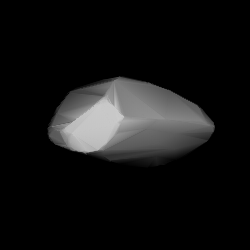Astronomy:1946 Walraven
 Modelled shape of Walraven from its lightcurve | |
| Discovery[1] | |
|---|---|
| Discovered by | H. van Gent |
| Discovery site | Johannesburg Obs. (Leiden Southern Station) |
| Discovery date | 8 August 1931 |
| Designations | |
| (1946) Walraven | |
| Named after | Theodore Walraven (astronomer)[2] |
| 1931 PH · 1952 PB 1959 RE1 · 1966 TC 1972 JE1 | |
| Minor planet category | main-belt · (inner)[3] |
| Orbital characteristics[1] | |
| Epoch 4 September 2017 (JD 2458000.5) | |
| Uncertainty parameter 0 | |
| Observation arc | 85.73 yr (31,314 days) |
| |{{{apsis}}}|helion}} | 2.8329 AU |
| |{{{apsis}}}|helion}} | 1.7564 AU |
| 2.2947 AU | |
| Eccentricity | 0.2346 |
| Orbital period | 3.48 yr (1,270 days) |
| Mean anomaly | 242.32° |
| Mean motion | 0° 17m 0.6s / day |
| Inclination | 8.1606° |
| Longitude of ascending node | 17.269° |
| 340.01° | |
| Physical characteristics | |
| Mean diameter | 9.205±0.109 km[4][5] 11.83 km (calculated)[3] |
| Rotation period | 10.21±0.01 h[6] 10.2101±0.0005 h[7] 10.22±0.02 h[8] 10.223 h[9] |
| Geometric albedo | 0.20 (assumed)[3] 0.362±0.067[4][5] |
| S[3] | |
| Absolute magnitude (H) | 11.9[4] · 12.0[1][3] |
1946 Walraven (prov. designation: 1931 PH) is a stony asteroid from the inner regions of the asteroid belt, approximately 10 kilometers in diameter. It was discovered on 8 August 1931, by Dutch astronomer Hendrik van Gent at Leiden Southern Station, annex to the Johannesburg Observatory in South Africa, and named after astronomer Theodore Walraven.[2][10]
Classification and orbit
Walraven is a stony S-type asteroid that orbits the Sun in the inner main-belt at a distance of 1.8–2.8 AU once every 3 years and 6 months (1,270 days). Its orbit has an eccentricity of 0.23 and an inclination of 8° with respect to the ecliptic.[1] The body's observation arc begins one day prior to its official discovery observation.[10]
Naming
This minor planet was named in honor of astronomer and pioneer in optical instrumentation and precision photometry, Theodore Fjeda Walraven (1916–2008),[11] who was a professor at the Leiden University and for many years resident astronomer at the former Leiden Southern Station near Hartbeespoortdam, South Africa.
Walraven constructed special photometers for the telescopes at the station, including the 5-color photometer for which he developed the Walraven photometric system.[2] The approved naming citation was published by the Minor Planet Center on 2 April 1988 (M.P.C. 12968).[12]
Physical characteristics
Rotation period
Four rotational lightcurves of Walraven were obtained from photometric observation, giving a rotation period between 10.210 and 10.223 hours with a brightness variation of 0.60 to 0.90 magnitude ({{{1}}}).[6][7][8][9]
Diameter and albedo
According to the survey carried out by NASA's Wide-field Infrared Survey Explorer with its subsequent NEOWISE mission, Walraven measures 9.2 kilometers in diameter and its surface has an albedo of 0.362,[4][5] while the Collaborative Asteroid Lightcurve Link assumes a standard albedo for stony asteroids of 0.20, and calculates a diameter of 11.8 kilometers with an absolute magnitude of 12.0.[3]
References
- ↑ 1.0 1.1 1.2 1.3 "JPL Small-Body Database Browser: 1946 Walraven (1931 PH)". Jet Propulsion Laboratory. https://ssd.jpl.nasa.gov/sbdb.cgi?sstr=2001946.
- ↑ 2.0 2.1 2.2 Schmadel, Lutz D. (2007). "(1946) Walraven". Dictionary of Minor Planet Names – (1946) Walraven. Springer Berlin Heidelberg. p. 156. doi:10.1007/978-3-540-29925-7_1947. ISBN 978-3-540-00238-3.
- ↑ 3.0 3.1 3.2 3.3 3.4 3.5 "LCDB Data for (1946) Walraven". Asteroid Lightcurve Database (LCDB). http://www.minorplanet.info/PHP/generateOneAsteroidInfo.php?AstInfo=1946%7CWalraven.
- ↑ 4.0 4.1 4.2 4.3 Mainzer, A.; Grav, T.; Masiero, J.; Hand, E.; Bauer, J.; Tholen, D. et al. (November 2011). "NEOWISE Studies of Spectrophotometrically Classified Asteroids: Preliminary Results". The Astrophysical Journal 741 (2): 25. doi:10.1088/0004-637X/741/2/90. Bibcode: 2011ApJ...741...90M.
- ↑ 5.0 5.1 5.2 Masiero, Joseph R.; Mainzer, A. K.; Grav, T.; Bauer, J. M.; Cutri, R. M.; Dailey, J. et al. (November 2011). "Main Belt Asteroids with WISE/NEOWISE. I. Preliminary Albedos and Diameters". The Astrophysical Journal 741 (2): 20. doi:10.1088/0004-637X/741/2/68. Bibcode: 2011ApJ...741...68M. http://adsabs.harvard.edu/cgi-bin/bib_query?bibcode=2011ApJ...741...68M. Retrieved 9 December 2016.
- ↑ 6.0 6.1 Aznar Macias, Amadeo; Carreno Garcerain, Alfonso; Arce Masego, Enrique; Brines Rodriguez, Pedro; Lozano de Haro, Juan; Fornas Silva, Alvaro et al. (July 2016). "Twenty-one Asteroid Lightcurves at Group Observadores de Asteroides (OBAS): Late 2015 to Early 2016". The Minor Planet Bulletin 43 (3): 257–263. ISSN 1052-8091. Bibcode: 2016MPBu...43..257A. http://adsabs.harvard.edu/cgi-bin/bib_query?bibcode=2016MPBu...43..257A. Retrieved 9 December 2016.
- ↑ 7.0 7.1 Hanus, J.; Durech, J.; Oszkiewicz, D. A.; Behrend, R.; Carry, B.; Delbo, M. et al. (February 2016). "New and updated convex shape models of asteroids based on optical data from a large collaboration network". Astronomy and Astrophysics 586: 24. doi:10.1051/0004-6361/201527441. Bibcode: 2016A&A...586A.108H. http://adsabs.harvard.edu/cgi-bin/bib_query?bibcode=2016A&A...586A.108H. Retrieved 9 December 2016.
- ↑ 8.0 8.1 Folberth, James; Casimir, Serick; Dou, Yueheng; Evans, Davis; Foulkes, Thomas; Haenftling, Miranda et al. (April 2012). "Asteroid Lightcurve Analysis at the Oakley Southern Sky Observatory: 2011 July-September". The Minor Planet Bulletin 39 (2): 51–55. ISSN 1052-8091. Bibcode: 2012MPBu...39...51F. http://adsabs.harvard.edu/cgi-bin/bib_query?bibcode=2012MPBu...39...51F. Retrieved 9 December 2016.
- ↑ 9.0 9.1 van Gent, H. (May 1933). "Period, light-curve, and ephemeris of the new asteroid with variable brightness 1931 PH". Bulletin of the Astronomical Institutes of the Netherlands 7: 65. Bibcode: 1933BAN.....7...65V. http://adsabs.harvard.edu/cgi-bin/bib_query?bibcode=1933BAN.....7...65V. Retrieved 9 December 2016.
- ↑ 10.0 10.1 "1946 Walraven (1931 PH)". Minor Planet Center. https://www.minorplanetcenter.net/db_search/show_object?object_id=1946.
- ↑ "Theodore Walraven (1916–2008) Dutch pioneer in optical instrumentation and precision photometry". Leiden Observatory. https://www.strw.leidenuniv.nl/jobs/theodore_walraven.php.
- ↑ "MPC/MPO/MPS Archive". Minor Planet Center. https://www.minorplanetcenter.net/iau/ECS/MPCArchive/MPCArchive_TBL.html.
External links
- Asteroid Lightcurve Database (LCDB), query form (info )
- Dictionary of Minor Planet Names, Google books
- Asteroids and comets rotation curves, CdR – Observatoire de Genève, Raoul Behrend
- Discovery Circumstances: Numbered Minor Planets (1)-(5000) – Minor Planet Center
- 1946 Walraven at AstDyS-2, Asteroids—Dynamic Site
- 1946 Walraven at the JPL Small-Body Database
 |

